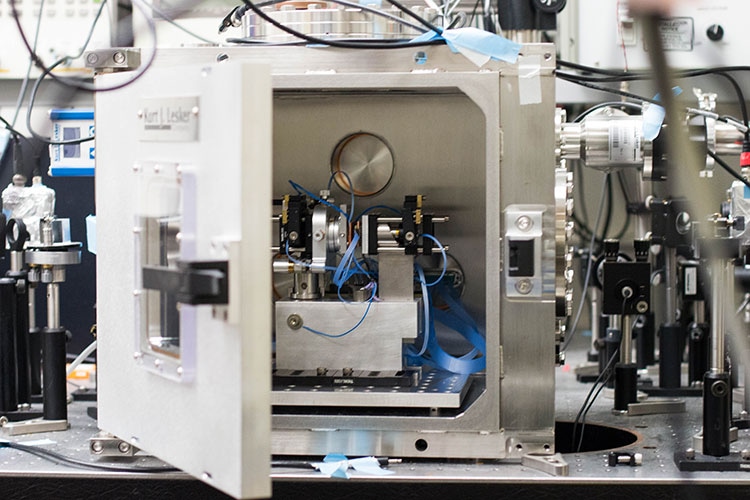Dec 12 2019
A vacuum-insulated thermos, which is generally used to keep the coffee hot, is an excellent insulator because heat energy cannot move easily through empty space.
 In a surprising new study, the University of California, Berkeley, researchers show that heat energy can travel through a complete vacuum thanks to invisible quantum fluctuations. To conduct the challenging experiment, the team engineered extremely thin silicon nitride membranes, which they fabricated in a dust-free clean room, and then used optic and electronic components to precisely control and monitor the temperature of the membranes when they were locked inside a vacuum chamber. Image Credit: Violet Carter, University of California, Berkeley.
In a surprising new study, the University of California, Berkeley, researchers show that heat energy can travel through a complete vacuum thanks to invisible quantum fluctuations. To conduct the challenging experiment, the team engineered extremely thin silicon nitride membranes, which they fabricated in a dust-free clean room, and then used optic and electronic components to precisely control and monitor the temperature of the membranes when they were locked inside a vacuum chamber. Image Credit: Violet Carter, University of California, Berkeley.
Atoms and molecules carry thermal energy, but their vibrations will no longer travel if molecules or atoms are not around.
Now, scientists at the University of California, Berkeley (UC Berkeley) have carried out a new study that demonstrates how this simple theory of classical physics can be turned on its head by the strange properties of quantum mechanics.
The study reveals that a quantum mechanical phenomenon known as the Casimir interaction allows heat energy to jump across a few hundred nanometers of a vacuum. The study has been recently published in the Nature journal.
While such an interaction is only important on very short length scales, it holds immense implications for designing nanoscale electronic components, including computer chips, where it is important to dissipate heat. The interaction also overturns what a majority of the individuals learned about the transfer of heat in their high-school physics.
Heat is usually conducted in a solid through the vibrations of atoms or molecules, or so-called phonons—but in a vacuum, there is no physical medium. So textbooks told us that phonons cannot travel through a vacuum. What we discovered, surprisingly, is that phonons can indeed be transferred across a vacuum by invisible quantum fluctuations.
Xiang Zhang, Professor, Department of Mechanical Engineering, University of California, Berkeley
The study was headed by Zhang. During the experiment, Zhang’s research team placed a pair of gold-coated silicon nitride membranes that were separated by a few hundred nanometers within a vacuum chamber. When one of the membranes was heated up, the other also warmed up—although there was nothing to join the two membranes except for an insignificant light energy traveling between them.
This discovery of a new mechanism of heat transfer opens up unprecedented opportunities for thermal management at the nanoscale, which is important for high-speed computation and data storage. Now, we can engineer the quantum vacuum to extract heat in integrated circuits.
Hao-Kun Li, Study Co-First Author and Former PhD Student, Department of Mechanical Engineering, University of California, Berkeley
Hao-Kun Li was part of Zhang’s group.
No Such Thing as Empty Space
Moving the vibrations of molecules over a vacuum is an apparently impossible feat. But now, this feat can be achieved because there is no such thing as truly empty space according to quantum mechanics, stated King Yan Fong, the other first author of the study and a former postdoctoral scholar at UC Berkeley.
Even if you have empty space—no matter, no light—quantum mechanics says it cannot be truly empty. There are still some quantum field fluctuations in a vacuum. These fluctuations give rise to a force that connects two objects, which is called the Casimir interaction. So, when one object heats up and starts shaking and oscillating, that motion can actually be transmitted to the other object across the vacuum because of these quantum fluctuations.
King Yan Fong, Study First Author and Former Postdoctoral Scholar, University of California, Berkeley
For a long time, theorists had been speculating that the Casimir interaction can allow the vibrations of molecules to pass through empty space, but it has been a significant challenge to prove this phenomenon at the experimental level.
To accomplish this feat, the researchers designed very thin silicon nitride membranes, which were created in a dust-free cleanroom. They subsequently developed a method to accurately regulate and track the temperature of these membranes.
The researchers discovered that heat energy can be transferred over a few hundred nanometers of vacuum by carefully choosing the design and size of the membranes. This distance was adequately far such that other potential modes of heat transfer were insignificant, for example, energy transmitted by electromagnetic radiation, which is how the Earth is heated up by the Sun’s energy.
Since vibrations of molecules are also the basis of the sounds heard by individuals, this discovery indicates that sounds are also capable of traveling through a vacuum, added Zhang.
“Twenty-five years ago, during my Ph.D. qualifying exam at Berkeley, one professor asked me ‘Why can you hear my voice across this table?’ I answered that, ‘It is because your sound travels by vibrating molecules in the air’. He further asked, ‘What if we suck all air molecules out of this room? Can you still hear me?’ I said, ‘No, because there is no medium to vibrate’,” stated Zhang.
Zhang continued, “Today, what we discovered is a surprising new mode of heat conduction across a vacuum without a medium, which is achieved by the intriguing quantum vacuum fluctuations. So, I was wrong in my 1994 exam. Now, you can shout through a vacuum.”
The study’s co-authors include Rongkuo Zhao, Sui Yang, and Yuan Wang from UC Berkeley.
The study was partly supported by the National Science Foundation (NSF) under grant 1725335, the Ernest S. Kuh Endowed Chair in Engineering, and the King Abdullah University of Science and Technology Office of Sponsored Research (OSR) (award OSR-2016-CRG5-2950-03; OSR-2016-CRG5-2996).